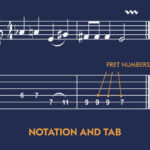The guitar harmonies in The Eagles’ “Hotel California” are instantly recognizable and a hallmark of classic rock. For guitar players, recreating that rich, layered guitar sound is a common goal. You might reach for a harmonizer pedal, expecting to easily dial in those iconic “Hotel California” guitar chords. However, many guitarists find that achieving a perfect replication is surprisingly elusive. It turns out, perfectly duplicating those famous guitar harmonies is more complex than it initially seems, presenting a challenge even for experienced players equipped with advanced gear.
The Inversion Challenge Explained
The difficulty in perfectly replicating the “Hotel California” guitar harmonies lies in the sophisticated way the chords are voiced and played by the guitars. It’s not just about strumming basic chord shapes; the magic is in the inversions. Let’s consider the very first chord in the sequence: B minor (Bm). The fundamental notes that constitute a Bm chord are B, F#, and D. In “Hotel California”, instead of simply playing a standard Bm shape, one guitar might be playing a voicing with the notes ordered as D, B, F#, while another guitar plays a different inversion, perhaps with the notes F#, D, B.
These are different inversions of the same Bm chord, meaning they contain the same notes but in a different order and register. This is where standard harmonizer pedals, which often rely on scales or pentatonic modes to generate harmonies, fall short. They are not designed to intelligently harmonize based on chord inversions.
Scale-Based Harmonizers vs. Chord-Specific Harmony Needs
Harmonizer pedals typically generate harmony notes based on musical scales. For example, if you select a Bm pentatonic scale (which includes the notes B, D, E, F#, A) on your harmonizer, it will create harmonies based on these notes relative to what you play. If you were to play a D note while using a harmonizer set to the Bm pentatonic scale, it might correctly harmonize it to F#.
However, if you then play a B note, the harmonizer, still operating within the Bm pentatonic scale, might produce an E as the harmony note. This is not the D note that’s required to perfectly replicate the “Hotel California” Bm chord harmony. This discrepancy highlights the core issue: standard harmonizers are designed for creating melodic harmonies within a scale, not for the nuanced, chord-specific harmonies created by inversions.
The F#7 Chord Complexity
Moving to the second chord in the “Hotel California” progression, F#7 (F#, Bb, C#, E), we encounter a similar complexity. Again, the guitar parts are not simply playing root position chords. One guitar might play a voicing of F#7 with the notes C#, Bb, F#, while another guitar plays a different inversion, perhaps E, C#, Bb. The crucial harmonic interest lies in the specific notes chosen for each guitar part, particularly the root (F#) and major third (Bb) in this F#7 chord.
The challenge is that to perfectly mimic this, a harmonizer would need to intelligently recognize the chord being played and generate harmonies based on specific chord tones and inversions, not just notes within a scale. Standard harmonizers simply aren’t equipped for this level of harmonic sophistication.
Whammy Pedal: A Potential, Though Imperfect, Workaround
While achieving perfect replication with standard harmonizers is difficult, one potential workaround, albeit a complex and likely imperfect one, could involve using a whammy pedal. A whammy pedal allows for pitch-shifting individual notes. In theory, you could use a whammy pedal to manually adjust the pitch of certain notes within the chords to create harmonies that are closer to the desired inversions.
However, this approach would be incredibly intricate and require a deep understanding of the specific voicings used in “Hotel California”. It would also be a far cry from a simple, automated solution and likely wouldn’t fully capture the subtle nuances of the original recording.
The Harmonic Journey Continues
It’s important to remember that these first two chords, Bm and F#7, are just the beginning of the “Hotel California” chord progression. The subsequent chords continue with similar harmonic complexity, utilizing inversions and carefully voiced guitar parts. This sustained level of intricate guitar arranging is what contributes to the unique and captivating sound of the song.
Conclusion: Appreciation for the Original Craftsmanship
In conclusion, while approximation of the “Hotel California” guitar harmonies is certainly achievable and can sound great, a perfect, easy duplication using standard harmonizers is highly unlikely. The intricacies of chord inversions and the specific voicing of guitar parts in the original recording present a significant challenge for automated harmonizers. This realization should lead to a greater appreciation for the masterful guitar work and arranging in the original “Hotel California” recording. It’s a testament to the artistry and skill of the musicians involved, and a valuable lesson for guitarists in the nuances of chord voicings and guitar harmony. If anyone does discover a simple method to perfectly nail that “Hotel California” harmony with a standard harmonizer, major kudos are indeed due!

